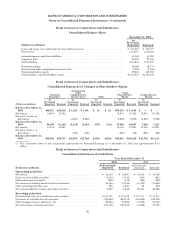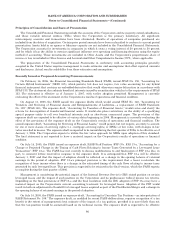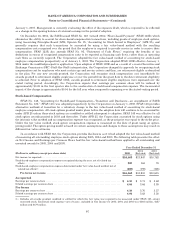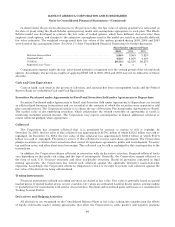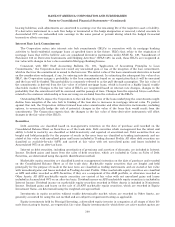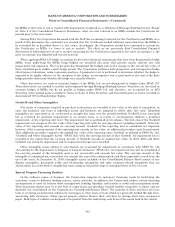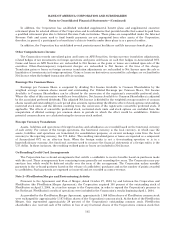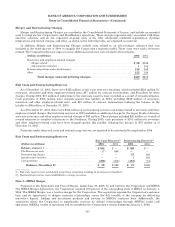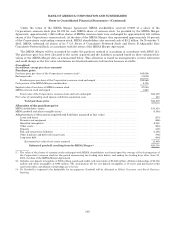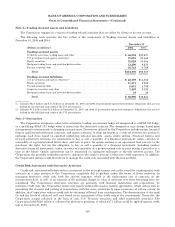Bank of America 2005 Annual Report Download - page 136
Download and view the complete annual report
Please find page 136 of the 2005 Bank of America annual report below. You can navigate through the pages in the report by either clicking on the pages listed below, or by using the keyword search tool below to find specific information within the annual report.BANK OF AMERICA CORPORATION AND SUBSIDIARIES
Notes to Consolidated Financial Statements—(Continued)
bearing liabilities, such adjustments are amortized to earnings over the remaining life of the respective asset or liability.
If a derivative instrument in a cash flow hedge is terminated or the hedge designation is removed, related amounts in
Accumulated OCI are reclassified into earnings in the same period or periods during which the hedged forecasted
transaction affects earnings.
Interest Rate Lock Commitments
The Corporation enters into interest rate lock commitments (IRLCs) in connection with its mortgage banking
activities to fund residential mortgage loans at specified times in the future. IRLCs that relate to the origination of
mortgage loans that will be held for sale are considered derivative instruments under SFAS No. 149, “Amendment of
Statement 133 on Derivative Instruments and Hedging Activities” (SFAS 149). As such, these IRLCs are recognized at
fair value with changes in fair value recorded in Mortgage Banking Income.
Consistent with SEC Staff Accounting Bulletin No. 105, “Application of Accounting Principles to Loan
Commitments,” the Corporation does not record any unrealized gain or loss at the inception of the loan commitment,
which is the time the commitment is issued to the borrower. The initial value of the loan commitment derivative is based
on the consideration exchanged, if any, for entering into the commitment. In estimating the subsequent fair value of an
IRLC, the Corporation assigns a probability to the loan commitment based on an expectation that it will be exercised
and the loan will be funded. This probability is commonly referred to as the pull through assumption. The fair value of
the commitments is derived from the fair value of related mortgage loans, which is based on a highly liquid, readily
observable market. Changes to the fair value of IRLCs are recognized based on interest rate changes, changes in the
probability that the commitment will be exercised and the passage of time. Changes from the expected future cash flows
related to the customer relationship or loan servicing are excluded from the valuation of the IRLCs.
Outstanding IRLCs expose the Corporation to the risk that the price of the loans underlying the commitments might
decline from inception of the rate lock to funding of the loan due to increases in mortgage interest rates. To protect
against this risk, the Corporation utilizes forward loan sales commitments and other derivative instruments, including
options, to economically hedge the risk of potential changes in the value of the loans that would result from the
commitments. The Corporation expects that the changes in the fair value of these derivative instruments will offset
changes in the fair value of the IRLCs.
Securities
Debt securities are classified based on management’s intention on the date of purchase and recorded on the
Consolidated Balance Sheet as Securities as of the trade date. Debt securities which management has the intent and
ability to hold to maturity are classified as held-to-maturity and reported at amortized cost. Debt securities that are
bought and held principally for the purpose of resale in the near term are classified as trading instruments and are
stated at fair value with unrealized gains and losses included in Trading Account Profits. All other debt securities are
classified as available-for-sale (AFS) and carried at fair value with net unrealized gains and losses included in
Accumulated OCI on an after-tax basis.
Interest on debt securities, including amortization of premiums and accretion of discounts, are included in Interest
Income. Realized gains and losses from the sales of debt securities, which are included in Gains on Sales of Debt
Securities, are determined using the specific identification method.
Marketable equity securities are classified based on management’s intention on the date of purchase and recorded
on the Consolidated Balance Sheet as of the trade date. Marketable equity securities that are bought and held
principally for the purpose of resale in the near term are classified as trading instruments and are stated at fair value
with unrealized gains and losses included in Trading Account Profits. Other marketable equity securities are classified
as AFS and either recorded as AFS Securities, if they are a component of the ALM portfolio, or otherwise recorded as
Other Assets. All AFS marketable equity securities are carried at fair value with net unrealized gains and losses
included in Accumulated OCI on an after-tax basis. Dividend income on AFS marketable equity securities is included in
Interest Income. Dividend income on marketable equity securities recorded in Other Assets is included in Noninterest
Income. Realized gains and losses on the sale of all AFS marketable equity securities, which are recorded in Equity
Investment Gains, are determined using the weighted average method.
Investments in equity securities without readily determinable market values are recorded in Other Assets, are
generally accounted for using the cost method and are subject to impairment testing as applicable.
Equity investments held by Principal Investing, a diversified equity investor in companies at all stages of their life
cycle from startup to buyout, are reported at fair value. Equity investments for which there are active market quotes are
100







